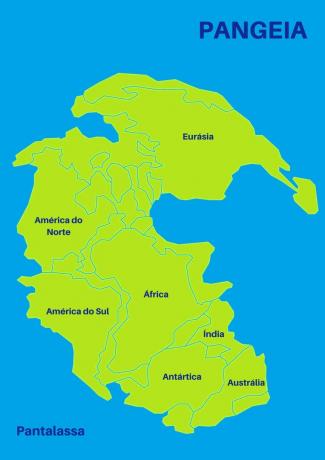Pangea was the huge continental mass that existed during the Paleozoic era, about 200 million years ago. O supercontinent it was surrounded by a single ocean, the Pantalassa.
The name Pangea derives from the Greek “pan”, which means all and “frost” which means earth.
This single continent was divided into two continental masses some 130 million years ago. These two continents became known as Laurasia and Gondwana and were cut by the new ocean, called tethys.
Laurasia corresponded to the continental parts that are now part of the northern hemisphere and Gondwana to the territories that are today in the southern hemisphere.
Approximately 65 million years ago, these two continental blocks began to divide and separated, until forming the current configuration of continents.
 The pangea was the union of all the continents existing today.
The pangea was the union of all the continents existing today.
Continental Drift Theory
The hypothesis that all continents were united in a supercontinent in the past was first proposed in the 16th century by the cartographer Abraham Ortelius, known as the creator of the modern Atlas.
Ortelius' proposition was based on the geographic similarity between the African continent and South America, which seemed to form a perfect fit. The researcher, however, had no other evidence to prove his hypothesis.
Following this idea, in 1912, the German Alfred Wegner published the Continental Drift Theory, which defended the existence of a single continent in the past.
Wegner originated his studies in finding the geographic similarity of the continents, but used other evidence to prove his theory.
The researcher found animal fossils of the same species in Africa and South America. These animals were not able to cross the ocean, which suggested that, at some point, the two continents were together.
Other evidence found by Wegner were rock formations similar on both continents.
What Wegner was unable to explain was how continents moved. His theory caused much controversy and was even ridiculed in scientific circles.
Plate Tectonic Theory
The Continental Drift Theory was only explained and accepted by the scientific community in the 1960s, when the existence of plate tectonics was discovered.
Plate tectonics are large hard rock blocks that lie beneath continents and oceans. This layer is divided into several boards that fit together.
These plates are seated on the earth's mantle and are in constant movement. The movement of these plates is responsible for tectonism, the formation of mountains, earthquakes and also the disposition of continents on the planet.
From this discovery, the gap left by Wegner was solved: it was not the moving continents, but the tectonic plates on which the continents and oceans lay.
Alfred Wegner died in 1930, 30 years before his theory was confirmed.
 Movement of continents over millions of years. Learn more about tectonic plates.
Movement of continents over millions of years. Learn more about tectonic plates.


